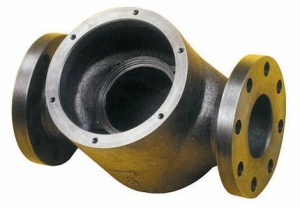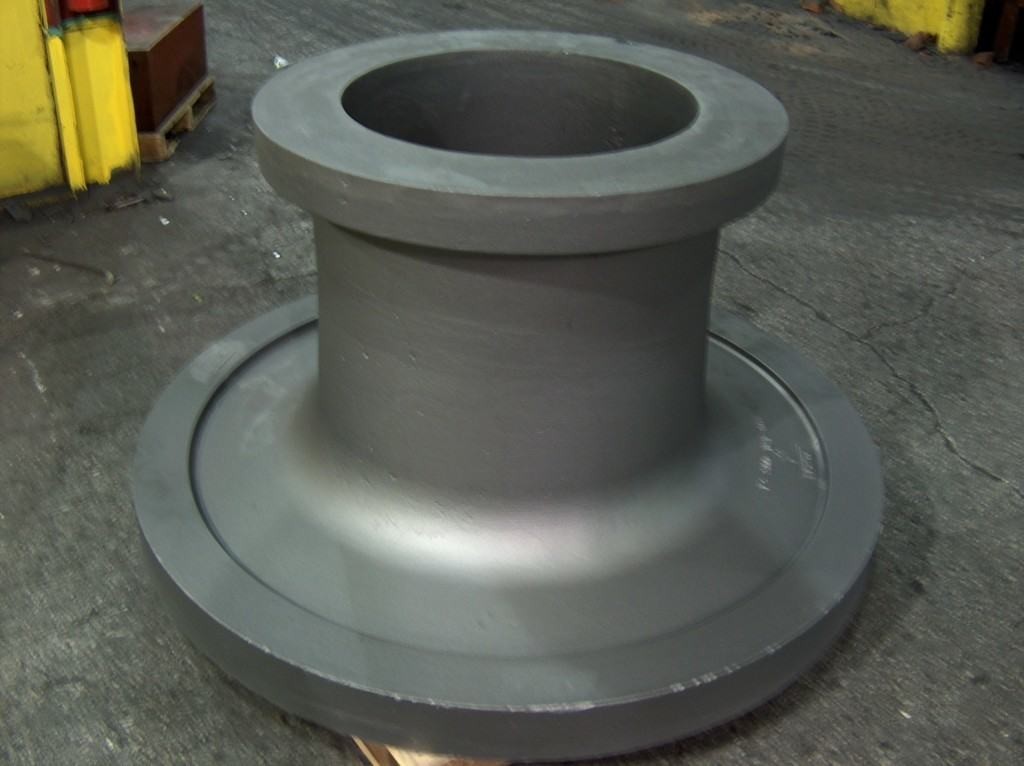What is Grey Cast Iron?
What is Grey Cast Iron?
Grey cast iron (a.k.a. gray iron) is a type of iron found in castings known for its grey color and appearance caused by graphite fractures in the material. Specifically, what makes it “grey iron,” is the graphite flake structure that is created during the cooling process from the carbon that is in the component.
Grey iron is a result of both the materials used and the process used to cast a part. In other words, the properties of the grey iron will change depending on what materials are melted together to pour into the mold as well as the process that is used for casting (it is primarily the cooling part of the process that defines the characteristics of the cast part versus other parts of the process.).
If you use a powerful microscope you can see the graphitic microstructure that makes grey iron so easily identifiable. In a grey iron casting, you can see little black flakes of graphite. These flakes cause fractures and cause the material to have a grey appearance. The mechanical properties of grey iron are controlled by the size and shape of the graphite flakes present in the microstructure.
There are more pounds of grey iron castings produced every year throughout the world than any other type of casting. Just about every manhole cover is from grey iron and the disc brakes on your car are most likely grey iron as well. Other common uses for grey iron include:
Gears
Hydraulic components
Automotive suspension components
Plow shares
Pumps
Linkages
Stove parts
Steering knuckles
Tractor parts
Valves
Truck suspension components
Other truck parts
Wind turbine housings.
Weights and counter-weights
Machinery bases
The popularity of grey cast iron components is because grey iron is one of the cheapest types of iron castings to produce. It has acceptable ductility, tensile strength, yield strength, and impact resistance for most applications. Grey Iron is also excellent in its ability to dampen vibrations making it ideal for machinery bases and as well as many housing applications. Grey iron has high thermal conductivity meaning it moves heat more easily through the metal.
A final benefit of grey iron is its ability to withstand thermal cycling well. Thermal cycling is where the component goes back and forth between warmer and colder temperatures. While thermal cycling can create stress and premature failure in some types of metal castings, grey iron has proven to endure the strain of thermal cycling quite well and not stress as easily.
While grey cast iron has less tensile strength and shock resistance than most other castings or even steal, it has compressive strength that is comparable to low- and medium-carbon steel. These mechanical properties are controlled by the size and shape of the graphite flakes present in the microstructure.
What are the Material Properties vs. Casting Processes?
Material properties come from the makeup of the materials present. Some of the materials are added to the iron for strength while others are added to improve castability (affecting melting temperatures, etc.). The properties of all metals are also influenced by the way they solidify during cooling. If you change the cooling process, you automatically change the structure of the metal in its final state. How the cast part cools can be affected by how the metal is introduced into the mold, the pouring temperature, and the process and speed of cooling. One of the difficulties in making a quality casting is to account for the way a part will cool in different parts of the mold, accounting for both thick and thin areas of the mold.
What is the Composition of Gray Cast Iron?
Just like all cast iron parts, the primary component of Grey Iron is going to be the iron (no surprise there, right?). Just like most other cast irons, it also has 2.5–4.0% carbon and 1–3% silicon. If you look at Chart 2 you will notice that the composition of the iron is very close to other common cast parts, but with a little more phosphorus.
| Iron Family | Gray | Ductile | CGI | Malleable | White |
| Carbon | 2.5-4.2 | 3.0-4.0 | 2.5-4.0 | 2.2-2.8 | 1.8-3.6 |
| Silicon | 1.0-3.0 | 1.8-3.0 | 1.5-3.0 | 1.2-1.9 | 0.5-2.0 |
| Manganese | 0.15-1.0 | 0.1-1.0 | 0.10-1.0 | 0.15-1.2 | 0.15-0.8 |
| Sulfur | 0.02-0.25 | 0.01-0.03 | 0.01-0.03 | 0.02-0.2 | 0.02-0.2 |
| Phosphorus | 0.02-1.0 | 0.01-0.1 | 0.01-0.1 | 0.02-0.2 | 0.02-0.2 |
What is the Microstructure of Grey Cast Iron
Grey iron has graphite flakes entwined with the rest of the structure. Unhardened grey iron is “fragile” compared to other cast metals. The graphite flakes create areas of weakness in the metal where fractures can begin that will split the metal. This propensity to fracture is why grey iron has low tensile and impact strength. Yet the graphite flakes are what create great wear resistance because as friction occurs the graphite acts as a lubricant. The graphite structure also has great vibration dampening properties because the structure created by the graphite flakes helps cancel out vibrations.
Classification of Grey Iron Classes
In the United States, the classification for grey iron is usually set using the ASTM International standard A48. ASTM A247 is also commonly used to describe the graphite structure. Grey iron is grouped into classes which correspond with its minimum tensile strength in thousands of pounds per square inch (ksi); (i.e. class 20 grey iron has a minimum tensile strength of 20,000 psi (140 MPa)). Other ASTM standards that deal with gray iron include ASTM A126, ASTM A278, and ASTM A319.
Class 20 grey iron has a ferrite matrix and a high carbon equivalent. Higher strength gray irons, up to class 40, have lower carbon equivalents and a pearlite matrix. To get grey iron above class 40 requires alloying to provide solid solution strengthening. Grey iron can also be heat treated which modifies the matrix giving the cast iron greater strength. Class 80 is the highest class available for grey iron and it makes the iron have high tensile strength but low impact resistance because class 80 parts are more brittle.
Standard Specifications
Below is a reference chart of other ASTM standards affecting grey iron.
ASTM A395 & ASME SA395: ferritic ductile iron pressure-retaining castings for
use at elevated temperatures
ASTM A439: austenitic ductile iron castings
ASTM A476 & ASME SA476: ductile iron castings for paper mill dryer rolls
ASTM A536 & SAE J434: ductile iron castings
ASTM A571 & ASME SA571: austenitic ductile iron castings for
pressure-containing parts suitable for low-temperature service
ASTM A874: ferritic ductile iron castings suitable for low-temperature service
ASTM A897: austempered ductile iron castings


